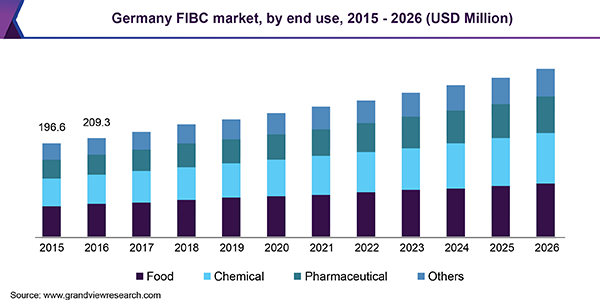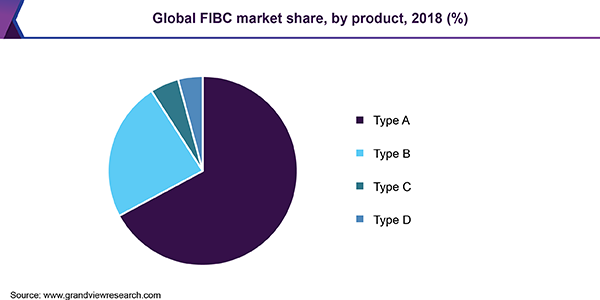
Flexible Intermediate Bulk Container Market Size, Share & Trends Analysis Report By Product (Type A, Type B, Type C, Type D), By End Use (Food, Chemical), By Region, And Segment Forecasts, 2019 - 2026
- Report ID: GVR-3-68038-695-0
- Number of Report Pages: 125
- Format: PDF
- Historical Range: 2015 - 2017
- Forecast Period: 2019 - 2025
- Industry: Bulk Chemicals
Industry Insights
The global flexible intermediate bulk container market size was valued at USD 4.0 billion in 2018 and is expected to advance at a CAGR of 5.9% over the forecast period. Rising food and pharmaceutical industries across the world, increasing need to reduce overall weight of bulk packaging, and growing manufacturing and construction sectors in Asia Pacific are the key factors driving the market growth.
Flexible intermediate bulk containers (FIBCs) are used in various end-use industries such as food, chemical, pharmaceutical, building & construction, agricultural, mining, manufacturing, and waste handling. The demand for FIBC in the pharmaceuticals industry is expected to progress at a higher pace owing to growing pharmaceutical industry across the world on account of aging population and rising chronic diseases.

Flexible intermediate bulk containers lower the total weight of bulk packaging owing to their negligible weight. They can be stored in a small space by folding and pressing multiple FIBCs together. FIBCs are made of flexible woven typically polypropylene (PP) and have a capacity to hold 500 kg to 2,000 kg of weight. These flexible intermediate containers are commonly used to store dry and flowable products such as grains, seeds, salts, chemicals, sands, clays, cement, and others. Primary end use of FIBC is to handle raw, semi-finished, and finished granules and small-size materials in industrial premises.
Filled flexible intermediate bulk containers are handled mechanically by forklifts in industrial premises. FIBCs are available at low costs, low weights, and are easy to handle. As a result of these benefits offered, FIBCs are widely used in food & beverages, pharmaceuticals, agricultural, and chemical industries. On account of the aforementioned benefits, their adoption rate in bulk packaging is considerably higher as compared to rigid and corrugated packaging.
End-Use Insights
Food and chemical are the key end-user industries for the global FIBC market. In the food industry, FIBCs are largely utilized in food processing companies and to handle agricultural products including grains, rice, potatoes, cereals, and others. Growing food processing industry owing to rise in per capita income is expected to drive the market over the forecast period.
In chemical and others segment, these flexible intermediate containers are widely utilized for handling PET, PTA, carbon black, steel, alloys, minerals. They are also used for construction materials such as cement, sand, and others. Steady growth rates of the global chemical and construction sectors are anticipated to favorably impact the global market.
Pharmaceutical segment for flexible intermediate bulk containers is expected to grow at the highest rate, in terms of both volume and revenue, over the forecast period. This can be attributed to favorable government regulations, rising chronic diseases, aging population, and rising importance of health and healthcare products & services in emerging countries on account of increasing spending capability.
Product Insights
Type A is a predominantly used type of flexible intermediate bulk container. In 2018, type A dominated product segment with a share of 67.4% of the overall revenue. Type A is a basic FIBC, which is made from plain polypropylene or other non-conductive materials. It does not possess any electrical charge dissipative properties, unlike other product types. Therefore, these FIBCs are not suitable for transporting any flammable materials such as powder form of products.

Key driving factors augmenting the demand for type A flexible intermediate bulk container are its lower costs as compared to other product types and wide availability across the world. In addition, large adoption of type A by end use industries including food, chemical, pharmaceutical, and others is attributed to its highest share in product types segment.
Type D flexible intermediate bulk container is expected to progress at the highest growth rate, in terms of both volume and revenue, in the global FIBC market over the forecast period. Its electric charge dissipative capability without grounding needs is a key factor contributing to its highest growth rate. This also makes type D a preferred option to carry flammable materials.
Regional Insights
Flexible intermediate bulk container (FIBC) market in North America is driven by the growing pharmaceutical industry in the region. The region held the largest share, in terms of both volume and revenue, in 2018 in the global market on account of high FIBC adoption by the large-scale chemical and manufacturing industries. In addition, the steady growth rates of food processing and agricultural markets in the region are expected to positively impact the demand for flexible intermediate bulk containers over the forecast period.
Furthermore, the building and construction sector in the MEA is growing significantly on account of increasing government and private spending on infrastructure, which, in turn, is driving the MEA market. In addition, the region has the presence of a large-sized chemical market leading to increased scope for flexible intermediate bulk containers in the sector. FIBC market in the MEA is projected to flourish significantly over the forecast period.
Asia Pacific market is expected to progress at the highest rate, in terms of both volume and revenue, from 2019 to 2026. China and India are among the largest agriculture producing countries in the world. In addition, China has the largest chemical industry in the world. Furthermore, pharmaceutical market in the region is growing at the highest rate as compared to the rest of the world. Therefore, on account of aforementioned factors, Asia Pacific market is projected to progress at a remarkable rate in terms of both volume and revenue, over the forecast period.
Flexible Intermediate Bulk Container Market Share Insights
The global flexible intermediate bulk container market is characterized by the presence of both global and domestic players. However, the market is highly fragmented with the presence of a large number of players across the regions. Key players operating in the market compete primarily on the basis of pricing. In order to strengthen their positions in the global market, countries in North America and Europe primarily outsource manufacturing activities to China, Turkey, and India to lower the production costs.
Some of the key players in the industry are Global-Pak, Bag Corp, Isbir Sentetik, Greif, Plastipak Industrial Textiles, Berry Plastics, Bulk Lift International, Halsted, Jumbo Bag Limited, Langston Companies Inc., Rishi FIBC Solutions, Taihua Group, Intertape Polymer Group, and LC Packaging.
Report Scope
|
Attribute |
Details |
|
Base year for estimation |
2018 |
|
Actual estimates/Historical data |
2015 - 2017 |
|
Forecast period |
2019 - 2026 |
|
Market representation |
Volume in Million Units; Revenue in USD Million & CAGR from 2019 to 2026 |
|
Report coverage |
Revenue forecast, company share, competitive landscape, growth factors and trends |
|
Region Scope |
North America, Europe, Asia Pacific, Central & South America, and Middle East & Africa |
|
Country Scope |
U.S., Germany, France, China, India, Japan, Brazil, UAE |
|
15% free customization scope (equivalent to 5 analyst working days) |
If you need specific information, which is not currently within the scope of the report, we will provide it to you as a part of customization |
Segments Covered in the Report
This report forecasts revenue growth at global, region, and country levels and provides an analysis of the industry trends in each of the sub-segments from 2015 to 2026. For the purpose of this study, Grand View Research has segmented the global flexible intermediate bulk container market report based on product, end-use, and region.
-
Product Outlook (Volume, Million Units; Revenue, USD Million, 2015 - 2026)
-
Type A
-
Type B
-
Type C
-
Type D
-
-
End-Use Outlook (Volume, Million Units; Revenue, USD Million, 2015 - 2026)
-
Food
-
Chemical
-
Pharmaceuticals
-
Others
-
-
Regional Outlook (Volume, Million Units; Revenue, USD Million, 2015 - 2026)
-
North America
-
The U.S.
-
-
Europe
-
Germany
-
France
-
-
Asia Pacific
-
China
-
India
-
Japan
-
-
Central & South America
-
Brazil
-
-
Middle East & Africa
-
UAE
-
-
We are committed towards customer satisfaction, and quality service.
"The quality of research they have done for us has been excellent."




